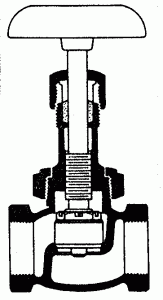Globe valves from Alloy Valve Stockist
Looking for valves in exotic alloys? We stock globe valves in 6MO 6moly), 254 SMO, 904L, AL-6XN, Alloy 20, Aluminum Bronze, Duplex, Hastelloy, Incoloy, Inconel, Monel, Nickel alloy, Austenitic stainless steel, Super Duplex, Titanium, Uranus B6 and Zirconium.
See also:
• Bellow seal globe valves
• Pressure seal globe valves
• Y-pattern globe valves
GLOBE VALVES .- Globe valves are probably the most common valves in existence. The globe valve derives its name from the globular shape of the valve body. However, positive identification of a globe valve must be made internally because other valve types may have globular appearing bodies. Globe valve inlet and outlet openings are arranged in several ways to suit varying requirements of flow. Figure-1 shows the common types of globe valve bodies: straight flow, angle-flow, and cross flow.

Source: “Inspection of Piping Systems“.
A total containment solution is available with the installation of a bellow seal globe valve constructed to positively eliminate any leak paths at the bonnet joint and packing. The valve, with its bellows and seal welded construction, totally confines the flow media within the valve pressure boundary. The valve packing is totally isolated by the bellows from the flowing medium and serves in a ”back up” role only.
Bellow seal globe valves seek to be zero emission and maintenance free. An uninterrupted metallic barrier is positioned between the piping and the environment. The components that during valve operation are subject to relative movements are welded onto the extremities of a metallic bellows that absorbs and compensates the shiftings. Hence these valves are suitable for any fluid and are recommended when zero emission characteristics are required to protect the environment and the health of the workers from pollutive leaks, to prevent expensive wastes due to loss of energy and fluid, and to eliminate the not negligible cost of replacement of the packing. In conclusion, the valves are particularly suitable for dangerous, inflammable, lethal and explosive media.
Pressure seal construction is adopted for valves for high pressure service, typically in excess of above 170 bar. The unique feature about the pressure seal Bonnet is that the body-Bonnet joints seals improves as the internal pressure in the Valve increases, compared to other constructions where the increase in internal pressure tends to create leaks in the body-bonnet joint.
Relying on fairly simple design principles, pressure seal valves have proven their capability to handle increasingly demanding fossil and combined-cycle steam isolation applications, as designers continue to push boiler, HRSG, and piping system pressure/temperature envelopes. Pressure seal valves are typically available in size ranges from 2 inches to 24 inches and ASME B16.34 pressure classes from #600 to #2500, although some manufacturers can accommodate the need for larger diameters and higher ratings for special applications.
Pressure seal valves are available in alloy grades for over 500�C. The pressure seal design concept can be traced back to the mid-1900s, when, faced with ever increasing pressures and temperatures (primarily in power applications), valve manufacturers began designing alternatives to the traditional bolted-bonnet approach to sealing the body/bonnet joint. Along with providing a higher level of pressure boundary sealing integrity, many of the pressure seal valve designs weighed significantly less than their bolted bonnet valve counterparts.
GLOBE VALVES .- Globe valves are probably the most common valves in existence. The Y-pattern globe valve pattern and larger seat bore allows for lower pressure drop than the standard globe-valve design. The globe valve derives its name from the globular shape of the valve body. However, positive identification of a globe valve must be made internally because other valve types may have globular appearing bodies. Globe valve inlet and outlet openings are arranged in several ways to suit varying requirements of flow. Figure-1 shows the common types of globe valve bodies: straight flow, angle-flow, and cross flow.



